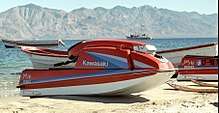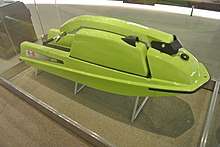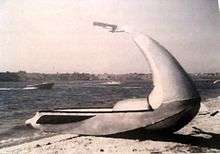Jet Ski
Jet Ski is the brand name of a personal water craft (PWC)[1] manufactured by Kawasaki,[2] a Japanese company.[3] The term is often used generically to refer to any type of personal watercraft used mainly for recreation, and it is also used as a verb to describe the use of any type of PWC.


A runabout style PWC typically carries 1–3 people seated in a configuration like a typical bicycle or motorcycle.
Kawasaki Jet Ski
"Jet Ski" is a proper noun and registered trademark of Kawasaki. The stand-up Kawasaki Jet Ski was the first "commercially successful" personal watercraft in America, having been released in 1972 (after reaching a license agreement with the inventor of the Sea-doo, Clayton Jacobson II when his license agreement with Bombardier expired).[2] The Kawasaki Jet Ski was the only commercial successful PWC for almost 16 years, from the introduction of the WSAA in October 1972 through the re-introduction of the sit-down, runabout style Bombardier Sea-Doo in 1988.[4] [5]

With the introduction of the Jet Ski, Kawasaki, in cooperation with aftermarket companies and enthusiasts, helped in creating the United States Jet Ski Boating Association (USJSBA). In 1982 the name was changed to the International Jet Sports Boating Association (IJSBA). At the start, only JS440 stand-ups were raced. After Kawasaki introduced the runabout style X2 in 1986 it gained its own class, later to be renamed the "Sport Class".[4]
Stand-up model history
1972–1976
Kawasaki introduces the first production stand-up PWC in October 1972. The WSAA and follow-on WSAB were powered by modified 400cc 2-stroke twin cylinder engines. The WSAA was designed with a flat hull and the WSAB came with a concave design. The design concepts distinctive of these original craft were a fully enclosed impeller for safety and self-righting, self-circling features. Without a lanyard the self circling allowed the rider to swim back to the idling craft after falling off. Kawasaki called them "Water Jet" and "Power Skis" before they settled on the name "Jet Ski".[6]
1976–1982
The 1976 JS400 was popular among thrill seeking recreational riders and racers. The 1977 JS440 offered more power and performance. It was one of Kawasaki's longest selling models. In 1982, Kawasaki responded to market demand for more performance with the JS550. The 550 featured a newly designed high capacity mixed flow pump driven by more powerful 531cc engine. The 550 introduced an automatic rev limiter to prevent engine damage when the pump cavitates.
1982–1986
Kawasaki continued to improve the JS550 well into the 1990s. In 1986, Kawasaki added the JS300 to their model line-up, a single cylinder 294cc two-stroke engine featuring automatic fuel /oil mixing. They also added the 650 X2, their first "sit-down" Jet Ski, and originator of the Sport Class for PWC racing.
1987–1992
Kawasaki introduces the completely redesigned JS650SX. It featured an even higher capacity axial flow pump and a powerful 635cc two-stroke twin engine in a modified V-hull design for increased maneuverability and stability.
In 1992, the company introduced a stand-up JS750-A. The engine was a twin cylinder 743cc two-stroke with reed valves and automatic oil injection. The redesigned hull was lighter weight and more maneuverable. The 750 introduced underwater exhaust for quieter operation to the stand-up kawasaki.
1995
The 750 SXi (JS750-B) is introduced, and became the first stand-up Jet Ski with dual carburetors.
1998
Kawasaki releases a commemorative edition JS550-C. The high performance JS750-C is released featuring a lower center of gravity due to its hand-laminated fiberglass hull.
2003
Kawasaki introduces the SX-R 800 (JS800A), which increased displacement to 781cc, in the form of an in-line twin 2-stroke engine generating 80hp. The SX-R also moved to a fiberglass reinforced plastic (FRP) hull and top deck.
2011
Due to US EPA restrictions, Kawasaki releases their final two-stroke stand-up, and the last year of the JS800 SX-R, to recognize the 37-year history of the stand-up JetSki. The model designation was JS800ABF, with an MSRP of $7899.00.[7]
2017
On October 6, 2016 Kawasaki reintroduced the stand-up Jet Ski. The 8 ft. 9 in., 550+ lb. SX-R 1500 shared little with its predecessors. Powered by a 160HP inline 4-cylinder four-stroke engine, the SX-R was described by one author as "on steroids" and having "lost some of the playfulness of early standup models".[8] It holds 6.1 gallons of fuel, measures 104.5" long, 30.1" wide and 33.1" high.[9]
Models
Kawasaki produced various models of the Jet Ski starting in 1972, beginning with the JS400 and leading up to the current JS1500.
2003 JS800A
The 800 SX-R was introduced for the 2003 model year, and remained unchanged until it was discontinued in 2011.
Motor
- Common name: 800 SX-R
- Displacement: 781cc, Inline 2-Cylinder, 2-Stroke
- Bore x stroke: 82 x 74mm
- Compression ratio: 7.2:1
- Rated Power Output: 80 hp, 59.7 kW
- Dual carb (Mikuni SBN40) with reed valves
- Premix ratio, gas/oil: 50:1
- Max fuel consumption (US gal/h): 7.7
- Range at full throttle: 0.6 hrs
- Spark plug: BR8ES Solid (NGK 3961)
- RPM Limiter: 8,000 rpm
Chassis
- Fuel capacity (gal): 4.5
- Length (in): 90.6
- Width (in): 28.7
- Height (in): 28.9
- Weight, dry (lb): 369.9
- Displacement (cc) to weight ratio: 2.11
- Max speed (mph): 47
- Impeller: Stainless steel 3 blade
Other stand-up manufacturers
In 1990 Yamaha introduced the Super Jet. It was designed in consultation with Clayton Jacobson II. It's final production year is 2020, with various updates throughout the model years.
In 1994-1995 Yamaha introduced the FX-1, which had a limited production of 1500 units.
In 2004 Bombardier introduced the Sea-Doo 3D. Unfortunately it had an ill-fated life and was only sold as 2005-2007 model years.
Various manufacturers produce a range of aftermarket competition hulls for stand-up PWCs.
References
- "Jet Ski". Cambridge English Dictionary. Archived from the original on 17 April 2017. Retrieved 7 May 2017.
- Josephson, Paul R. (2007). Motorized Obsessions: Life, Liberty, and the Small-Bore Engine. JHU Press. p. 150. ISBN 9780801886416. Retrieved 2012-08-24.
- "Japanese inventions that changed the world". CNN. Archived from the original on 2017-11-03.
- Vasilis Moraitis. "Jet Ski History 1973-2012". Jetskiworld. Archived from the original on 13 January 2018. Retrieved 12 January 2018.
- Vasilis Moraitis. "Kawasaki Jet Ski stand-up 37 years history - World Exclusive Legendary stand-ups". Jetskiworld. Archived from the original on 19 January 2018. Retrieved 18 January 2018.
- "History of the Jet Ski - stand-up watercraft". JetSki Club. 5 March 2014. Retrieved 12 February 2018.
- "2011 KAWASAKI JET SKI® 800 SX-R". Personal Watercraft. 14 April 2011. Archived from the original on 11 July 2018. Retrieved 10 July 2018.
- Jeff Hemmel (12 June 2017). "Kawasaki Jet Ski SXR Review". Boats.com. Archived from the original on 17 January 2018. Retrieved 16 January 2018.
- Jeff Hemmel (23 April 2017). "KAWASAKI SX-R REVIEW- BACK AND BETTER". JetSkiTips.com. Retrieved 20 June 2018.